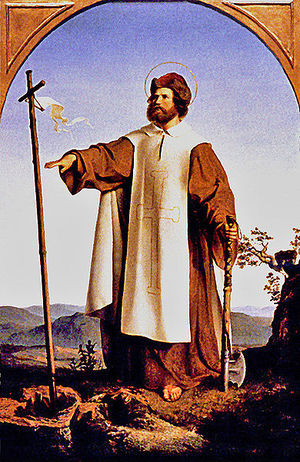Saint Boniface
Saint Boniface (c. 675 - June 5, 754/755) was the most famous Christian missionary in Germany. A Catholic Missionary sent by the Pope to convert Germany from paganism to Christ, St. Boniface is the reason Germany was Christian for so many centuries. He is also called the "apostle of the Germans".
Biography
Boniface, then Winfrid, was born in England. His year of birth is unknown, but based on his age at death of around 80, would be approximately 675. Boniface descended from a noble family and received a religious education. Later he went to the monastery of Exeter and Nursling, where he was ordained as priest. 716 Boniface he tried for first time a missionary journey in Frisia, Germany, that failed because of political disturbances. 718 Boniface again left England and travelled to Rome, where Pope Gregory II commissioned him to convert the Germans. He travelled through Bavaria, Thuringia and Hesse, where he spread Christian faith. His most famous action was the precipitation of an oak in Geismar, that was consecrated to the thunder-god Thor. The heathens, who saw this felling were surprised because they expected vengeance by Thor. Many of them were converted.[1]
Martyrdom
After a long and glorious missionary career, St. Boniface, the Apostle of Germany, was martyred for the Christian Faith. "When Boniface saw that all things had been properly taken care of, he took up the work he had dreamed of in early manhood, the conversion of the Frisians. With royal consent, and with that of the pope previously given, he in 754 resigned the Archdiocese of Mainz to his disciple Lullus, whom in 752 he had consecrated bishop, again commenced a missionary tour, and laboured with success to the East of the Zuider Zee. Returning in the following year, he ordered the new converts to assemble for confirmation at Dorkum on the River Borne. The heathens fell upon them and murdered Boniface and fifty-two companions (according to some, thirty-seven). Soon afterwards, the Christians, who had scattered at the approach of the heathens, returned and found the body of the martyr and beside him the bloodstained copy of St. Ambrose on the "Advantage of Death"[2]
